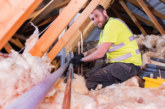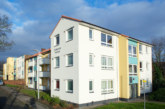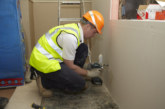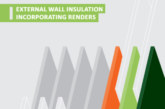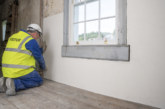Mishandling external wall insulation installation can create and exacerbate rising damp problems. This is why care must be taken to fix fabrics first, especially in respect of PAS 2035 retrofits, says Hudson Lambert, Director of Safeguard.
External wall insulation (EWI) — the application of an insulation layer fixed to the existing facade, with a protective render or decorative finish — is a popular and very effective way of transforming houses into warm, energy-efficient and modern-looking buildings. However, the absence of a proper survey, defects in the building fabric and the possibility of installation errors mean there’s a good chance that EWI will make any problem with rising damp far worse.
EWI reduces the risk of vapour condensing on the inside skin of the wall as the dew point temperature moves closer to the external face of the insulated wall. When installed correctly, it can also protect against penetrating damp, which is caused by driving rain. However, it is crucial to survey the property before installation and treat any issue with rising damp. Not doing so means the EWI will simply trap the damp inside the walls and make the problem worse. It is also important to ensure that there are no gaps, at the eaves for example, where rain can find its way in and get trapped behind the insulation.
This has always been the case, yet the Government’s PAS 2035 Retrofitting Dwellings for Improved Energy Efficiency scheme and the Green Homes Grant have heightened concerns about the risk. PAS 2035 has been inspired by the Government’s commitment to achieving a Net Zero Carbon economy by 2050. This requires a significant improvement in the energy efficiency of domestic properties — and a huge number of energy-efficient retrofit projects — as, in 2017, the UK’s housing stock was responsible for 13% of the UK’s carbon emissions.
According to statistics from the Insulated Render and Cladding Association (INCA) there are around eight million homes with solid walls in the UK, a third of UK housing, and half of them are occupied by people in fuel poverty. All these properties need some form of insulation to stop heat being lost through their walls — the choices effectively being limited to Internal Wall Insulation (IWI) and EWI.

Rising damp
Rising damp occurs because water travels up through the pores in a wall’s material, with the height it reaches governed by a combination of pore size and the rate of evaporation from the surface of the wall. Cover either side of a wall up and you prevent evaporation, although with IWI the problem is less obvious as it is hidden and may take some time to emerge.
Typically, rising damp only rises to a few inches and remains concealed by skirting boards. It becomes a real issue when it reaches heights where it can impact upon structural elements such as floor joists, or damage interior décor, with occupants noticing blistering paint or peeling wallpaper. Anything that prevents evaporation — such as EWI over a failed or non-existent damp-proof course (DPC) — can drive the damp line up to 1m or more. (In Venice, heights of 6m have been recorded!)
Where severe rising damp is present in a property where EWI is planned, advice should be sought from a specialist surveyor. However, installing a remedial DPC can treat cases that are not severe quickly and cheaply.

Treating rising damp
The treatment of rising damp can be costly, especially when expensive replastering is required. However some damp-proofing products are more effective and reduce the need for replastering and there are now fast, low cost replastering systems which have recently reached the market.
Installing a DPC has been greatly simplified with the development of modern products that can be installed rapidly. Holes are drilled at set intervals along a mortar bed and damp-proofing rods inserted. The chemicals the rods diffuse out to form a new DPC.
The potential problems with rising damp should not be a reason to discount EWI as a possible solution to solid-walled properties requiring insulation. It is a vital tool in improving the energy efficiency of our housing stock and decreasing the UK’s carbon emissions.
However, it is important that more care is taken when surveying properties prior to EWI installation, so that even the most minor cases of rising damp are treated. The last thing that anybody wants to see is measures aimed at improving a household’s quality of life leading to damp and the health issues that it can cause.


